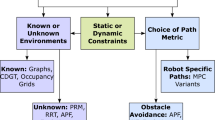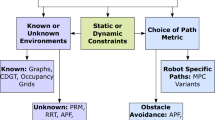Abstract
There are many applications in motion planning where it is important to consider and distinguish between different topological classes of trajectories. The two important, but related, topological concepts for classifying manifolds that are of importance to us are those of homotopy and homology. In this paper we consider the problem of robot exploration and planning in Euclidean configuration spaces with obstaclees to (a) identify and represent different homology classes of trajectories; (b) plan trajectories constrained to certain homology classes or avoiding specified homology classes; and (c) explore different homotopy classes of trajectories in an environment and determine the least cost trajectories in each class. We exploit theorems from complex analysis and the theory of electromagnetism to solve the problem 2-dimensional and 3-dimensional configuration spaces respectively. Finally, we describe the extension of these ideas to arbitrary D-dimensional configuration spaces. We incorporate these basic concepts to develop a practical graph-search based planning tool with theoretical guarantees by combining integration theory with search techniques, and illustrate it with several examples.



















Similar content being viewed by others
References
Bhattacharya, S., Kumar, V., & Likhachev, M. (2010). Search-based path planning with homotopy class constraints. In Proceedings of the twenty-fourth AAAI conference on artificial intelligence, Atlanta, Georgia, 11 July 2010.
Bhattacharya, S., Likhachev, M., & Kumar, V. (2011a). H-signature for general euclidean spaces. Technical report, The University of Pennsylvania. See, https://fling.seas.upenn.edu/~subhrabh/cgi-bin/wiki/index.php?SFile=HSignatureHigherDim.
Bhattacharya, S., Likhachev, M., & Kumar, V. (2011b). H-signature of a non-looping trajectory with respect to an infinite straight line skeleton. Technical report, The University of Pennsylvania. See, https://fling.seas.upenn.edu/~subhrabh/cgi-bin/wiki/index.php?SFile=HSignatureNonLooping.
Bhattacharya, S., Likhachev, M., & Kumar, V. (2011c). Identification and representation of homotopy classes of trajectories for search-based path planning in 3d. In Proceedings of robotics: science and systems, 27–30 June 2011.
Bhattacharya, S., Likhachev, M., & Kumar, V. (2012). A homotopy-like class invariant for sub-manifolds of punctured euclidean spaces. Technical report, University of Pennsylvania. See, https://fling.seas.upenn.edu/~subhrabh/cgi-bin/wiki/index.php?WPage=chihomotopy.
Blum, H. (1967). A transformation for extracting new descriptors of shape. In W. W. Dunn (Ed.), Models for the perception of speech and visual form (pp. 362–380). Cambridge: MIT Press.
Bott, R., & Tu, L. W. (1982). Differential forms in algebraic topology. In Graduate texts in mathematics. Berlin: Springer.
Bourgault, F., Makarenko, A. A., Williams, S. B., Grocholsky, B., & Durrant-Whyte, H. F. (2002). Information based adaptive robotic exploration. In Proceedings IEEE/RSJ international conference on intelligent robots and systems (IROS) (pp. 540–545).
Demyen, D., & Buro, M. (2006). Efficient triangulation-based pathfinding. In AAAI’06: proceedings of the 21st national conference on artificial intelligence (pp. 942–947). Melno Park: AAAI Press.
Flanders, H. (1989). Differential forms with applications to the physical sciences. New York: Dover.
Griffiths, D. J. (1998). Introduction to electrodynamics (3rd ed.). Redwood-City: Benjamin-Cummings.
Grigoriev, D., & Slissenko, A. (1998). Polytime algorithm for the shortest path in a homotopy class amidst semi-algebraic obstacles in the plane. In ISSAC ’98: proceedings of the 1998 international symposium on symbolic and algebraic computation, New York, NY, USA (pp. 17–24). New York: ACM.
Hart, P. E., Nilsson, N. J., & Raphael, B. (1968). A formal basis for the heuristic determination of minimum cost paths. IEEE Transactions on Systems, Science, and Cybernetics, 4(2), 100–107.
Hatcher, A. (2001). Algebraic topology. Cambridge: Cambridge University Press.
Hershberger, J., & Snoeyink, J. (1991). Computing minimum length paths of a given homotopy class. Computational Geometry, 4, 331–342.
Jain, A. K. (1989). Fundamentals of digital image processing. Upper Saddle River: Prentice-Hall.
Munkres, J. (1999). Topology. New York: Prentice Hall.
Rotman, J. J. (1988). An introduction to algebraic topology. Berlin: Springer.
Schmitzberger, E., Bouchet, J. L., Dufaut, M., Wolf, D., & Husson, R. (2002). Capture of homotopy classes with probabilistic road map. In International conference on intelligent robots and systems (Vol. 3, pp. 2317–2322).
Schwager, M., Dames, P., Kumar, V., & Rus, D. (2011). Multi-robot mapping and exploration of environments with hazards. In RSS 2011 workshop on 3D exploration, mapping, and surveillance with aerial robots.
Svec, A. (2001). Global differential geometry. Berlin: Springer.
Talpaert, Y. (2000). Differential geometry with applications to mechanics and physics. Boca Raton: CRC Press.
Zhou, Y., Hu, B., & Zhang, J. (2006). Occlusion detection and tracking method based on bayesian decision theory. In L.-W. Chang & W.-N. Lie (Eds.), Lecture notes in computer science: Vol. 4319. Advances in image and video technology (pp. 474–482). Berlin: Springer.
Acknowledgements
We gratefully acknowledge support from the ONR Antidote MURI project, grant no. N00014-09-1-1031; ONR Grants N00014-08-1-0696 and N00014-09-1-1052; and NSF Grant IIP-0742304.
We would like to thank Prof. Robert Ghrist and Dr. David Lipsky, University of Pennsylvania, for providing valuable insights on homology theory.
We would like to thank Mr. Dimitar Simeonov and Mr. Michael Fleder, Computer Science and Artificial Intelligence Laboratory, MIT, for providing us with the example described in Fig. 2(a) that illustrates the distinction between the equivalence of homotopy and that of homology classes of trajectories in 2-D.
Author information
Authors and Affiliations
Corresponding author
Electronic Supplementary Material
Rights and permissions
About this article
Cite this article
Bhattacharya, S., Likhachev, M. & Kumar, V. Topological constraints in search-based robot path planning. Auton Robot 33, 273–290 (2012). https://doi.org/10.1007/s10514-012-9304-1
Received:
Accepted:
Published:
Issue Date:
DOI: https://doi.org/10.1007/s10514-012-9304-1




